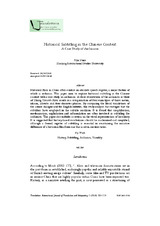Mostrar el registro sencillo del ítem
Historical subtitling in the chinese context: a case study of archaisms
| dc.contributor.author | Yuan, Yilei | |
| dc.date.accessioned | 2019-04-10T07:18:20Z | |
| dc.date.available | 2019-04-10T07:18:20Z | |
| dc.date.issued | 2018 | |
| dc.identifier.issn | 2605-2954 | |
| dc.identifier.uri | http://hdl.handle.net/10396/18389 | |
| dc.description.abstract | Historical films in China often contain an obsolete speech register, a major feature of which is archaism. This paper aims to explore historical subtitling in the Chinese context with a case study on archaisms. A close observation of the archaisms in three of Zhang Yimou’s films results in a categorisation of four main types of them: nouns, idioms, adverbs and four-character phrases. By comparing the literal translations of the source dialogue and the English subtitles, this study analyses the strategies that the subtitlers have employed in the subtitle rendition. It is found that simplification, modernisation, explicitation and reformulation are often involved in subtitling the archaisms. This paper also includes a section on the visual representation of historicity. It is suggested that history-based vocabularies should be modernised and simplified, although a formal register of subtitling is essential in maintaining the narrative difference of a historical film from one that is set in modern times. | es_ES |
| dc.format.mimetype | application/pdf | es_ES |
| dc.language.iso | eng | es_ES |
| dc.publisher | UCOPress | es_ES |
| dc.rights | https://creativecommons.org/licenses/by/3.0/ | es_ES |
| dc.source | Transletters. International Journal of Translation and Interpreting 2, 205-223 (2018) | es_ES |
| dc.subject | History | es_ES |
| dc.subject | Subtitling | es_ES |
| dc.subject | Archaism | es_ES |
| dc.subject | Visuality | es_ES |
| dc.title | Historical subtitling in the chinese context: a case study of archaisms | es_ES |
| dc.type | info:eu-repo/semantics/article | es_ES |
| dc.relation.publisherversion | https://www.uco.es/ucopress/ojs/index.php/tl/index | es_ES |
| dc.rights.accessRights | info:eu-repo/semantics/openAccess | es_ES |

